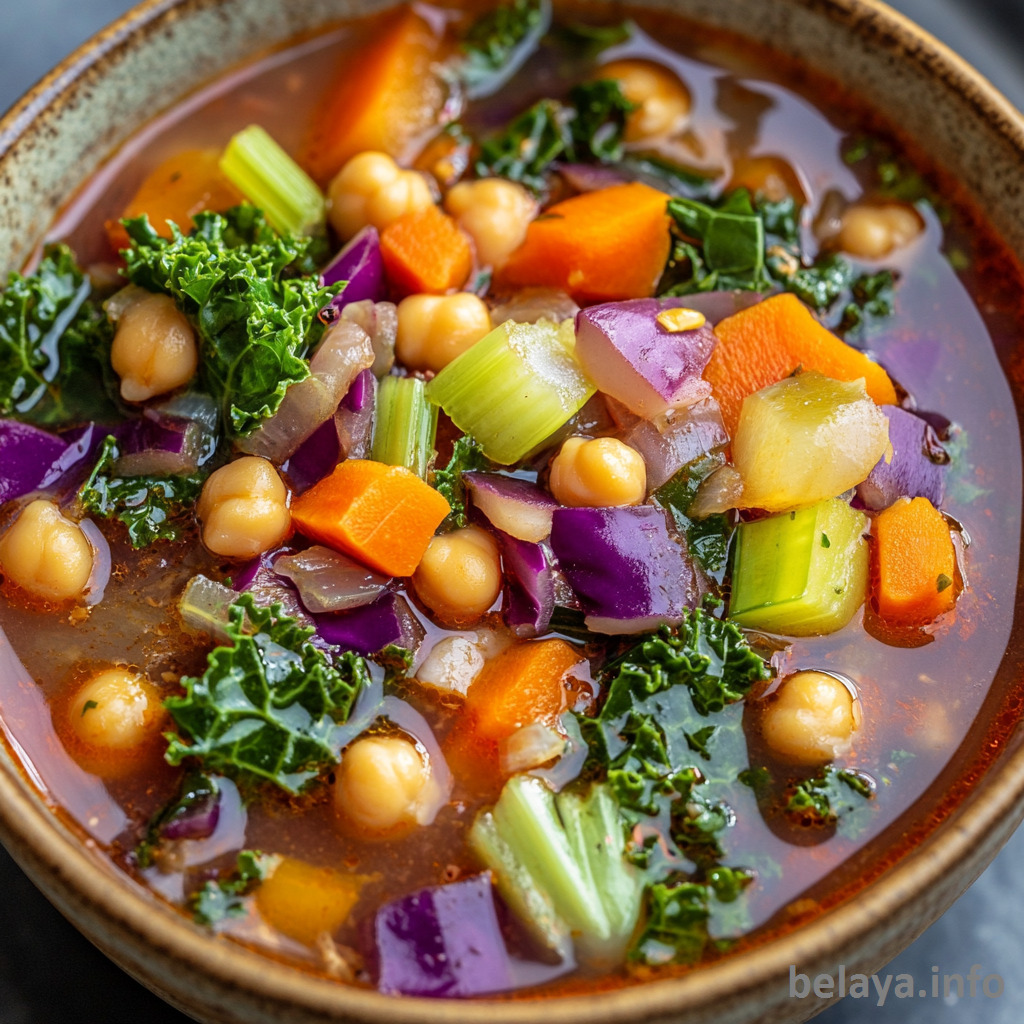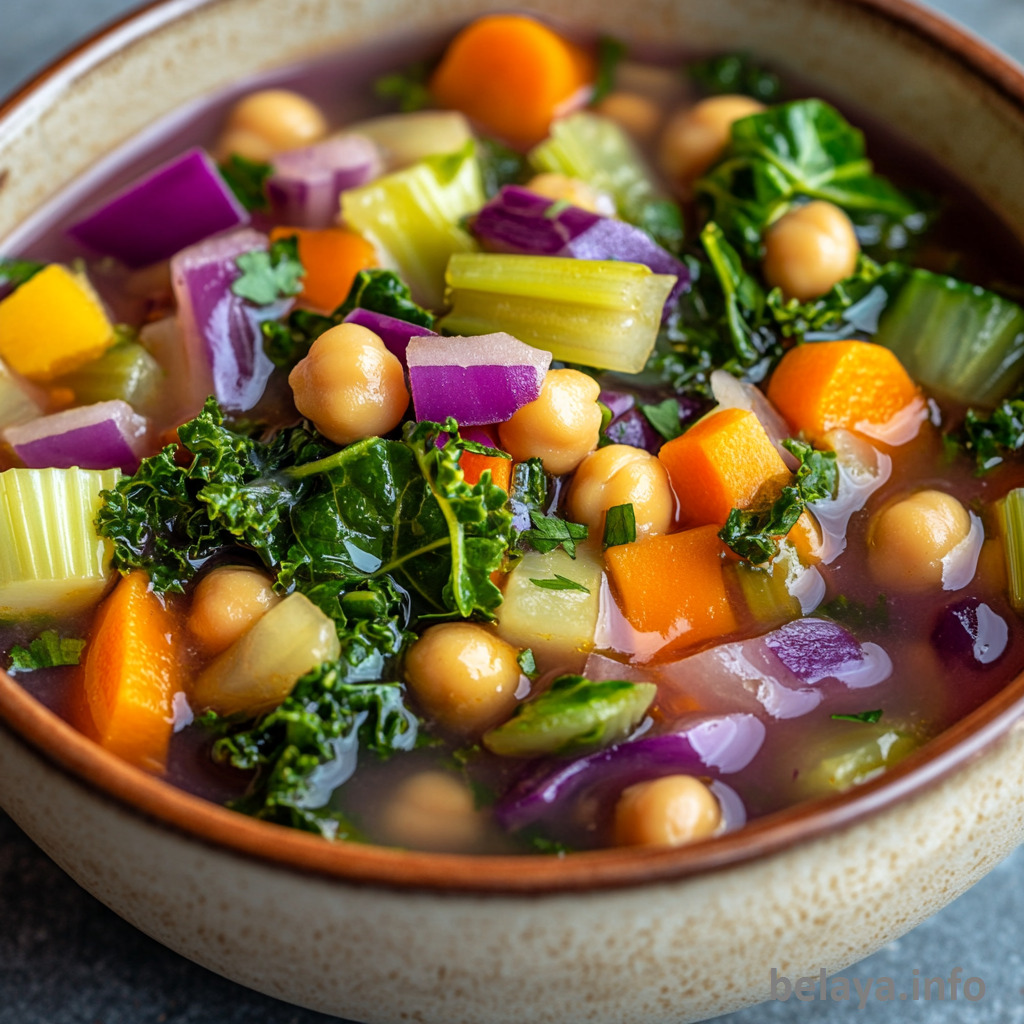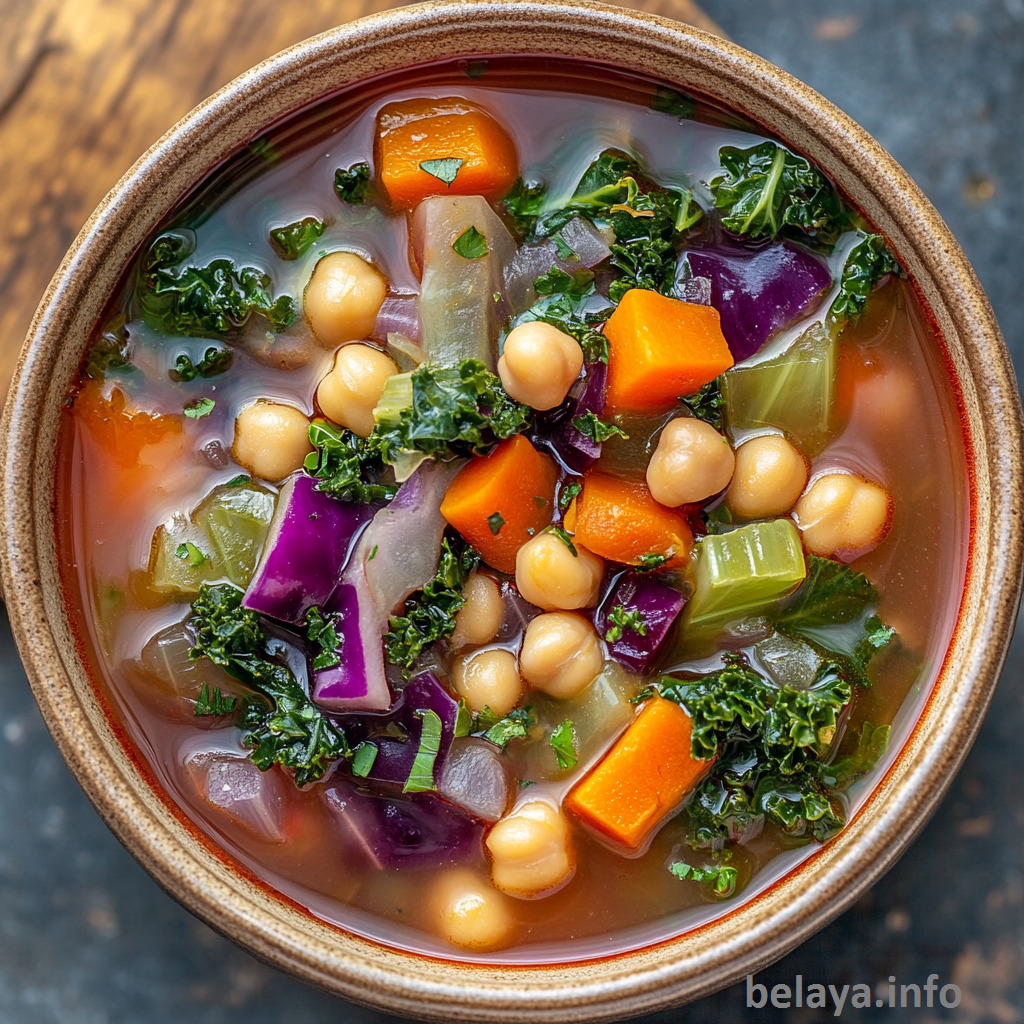Vegetable Detox Soup
Vegetable Detox Soup is a restorative, nutrient-packed dish designed to refresh the body and soothe the digestive system. Brimming with vibrant vegetables like red cabbage, kale, zucchini, and parsnip, this soup delivers a wealth of fiber, antioxidants, and cleansing herbs in every spoonful.
The addition of chickpeas offers gentle plant-based protein, while lemon juice and fresh thyme brighten and awaken the broth. It’s not just a detox—it’s a bowl of warmth, simplicity, and balance, ideal for resetting after indulgent days or nourishing your body through colder months.
Whether enjoyed as a light lunch or comforting dinner, this soup is both grounding and revitalizing.

Why People Will Love This Vegetable Detox Soup Recipe:
Nutrient-dense and cleansing: Packed with fiber-rich vegetables, legumes, and leafy greens, this soup supports digestion, detoxification, and gut health—all while feeling light yet satisfying.
Naturally anti-inflammatory: Ingredients like garlic, thyme, kale, and red cabbage contain antioxidants and phytonutrients that help reduce inflammation and support immune function.
A warm, gentle reset for the body: This soup offers a soothing way to nourish the body after periods of heavy eating or stress, giving you energy without weighing you down.
Balanced flavor from fresh herbs and lemon: The brightness of fresh thyme and lemon juice adds a layer of depth that cuts through the earthiness of the vegetables, creating a broth that feels clean yet complex.
Versatile and adaptable: Whether you’re vegan, gluten-free, recovering from illness, or simply craving something wholesome, this recipe fits many dietary needs and can be customized easily.
Comforting and mindful to eat: Its slow-simmered warmth invites intentional, mindful eating—perfect for cozy evenings or moments when you want to reconnect with simple, nourishing food.

Key Ingredients:
Onion, Carrot, Celery, and Parsnip: This classic aromatic base forms the foundation of the soup’s flavor. Rich in fiber, antioxidants, and prebiotics, these vegetables gently support digestion and provide natural sweetness and depth to the broth.
Zucchini and Red Cabbage: Zucchini adds a light, creamy texture once cooked, while red cabbage infuses the soup with vibrant color and cruciferous power—supporting liver detoxification and anti-inflammatory pathways.
Garlic and Fresh Thyme: These immune-boosting herbs do more than flavor the broth. Garlic acts as a natural antimicrobial, while thyme offers both digestive support and a subtle, earthy fragrance that rounds out the aromatics.
Chickpeas: Providing plant-based protein and fiber, chickpeas help stabilize blood sugar, promote satiety, and give the soup a heartier bite without making it heavy.
Tuscan Kale: This leafy green is a nutritional powerhouse—rich in chlorophyll, calcium, and vitamins A, C, and K. Lightly wilted at the end, it adds structure, color, and cleansing properties without overpowering the other vegetables.
Lemon Juice: A finishing touch that awakens the entire dish. The acidity balances the sweetness of the root vegetables and enhances mineral absorption while also aiding liver function.
Vegetable Stock: A clean, light base that carries all the ingredients without overwhelming them. It allows the natural character of each vegetable to shine while creating a warming, nourishing broth.

Expert Tips:
Sweat the aromatics slowly for layered depth: Don’t rush the initial sauté. Cooking the onion, carrot, celery, and parsnip low and slow (8–10 minutes) allows their natural sugars to caramelize slightly, building a subtle sweetness and complexity that enriches the broth without needing added fat or salt.
Cut vegetables in uniform sizes for even cooking: Dice the vegetables to similar sizes so they cook evenly and release flavor consistently. This ensures every spoonful delivers a harmonious texture and balanced mouthfeel.
Bloom the herbs and garlic in oil: Add the garlic, oregano, and thyme after the vegetables have softened and cook them briefly before adding the stock. This step—called “blooming”—activates their essential oils and deepens the flavor of the soup.
Simmer gently, not vigorously: A soft, steady simmer prevents the vegetables from breaking down too much and helps preserve the color and nutrients of delicate ingredients like kale and cabbage.
Add kale and lemon juice at the very end: To retain their brightness and nutritional potency, stir in kale and lemon juice during the final 2–3 minutes of cooking. This protects kale’s texture and preserves lemon’s vitamin C content.
Use homemade or low-sodium vegetable stock for control: A clean, neutral stock lets the vegetables speak for themselves. Homemade is ideal, but if using store-bought, choose a low-sodium version to better control salt levels and keep the soup light.
Let the soup rest before serving: After cooking, let the soup sit off the heat for 10–15 minutes. This allows flavors to meld and deepens the taste without further softening the vegetables.
Garnish for contrast and function: A drizzle of olive oil, sprinkle of hemp seeds, or a few chili flakes right before serving adds texture, essential fats, and a touch of heat—making the soup feel complete and nutritionally balanced.

Vegetable Detox Soup
Ingredients
1 tablespoon olive oil
1 medium onion, diced
1 medium carrot, diced
2-3 celery sticks, diced
1 medium parsnip, diced
1 medium zucchini, cubed
½ small red cabbage, sliced (about ½ lb/ 225 g)
2 large garlic cloves, minced
1 teaspoon dried oregano
1-2 tablespoons fresh thyme, finely chopped
1 can (14 oz / 400 g) chickpeas, drained and rinsed
6 cups (1.5 litres) vegetable stock
Juice of half a lemon
2 cups (75 g) Tuscan kale, roughly chopped
Salt and freshly ground black pepper to taste
Instructions
Sauté the base vegetables:
Heat the olive oil in a large stockpot or Dutch oven over medium heat.
Add the diced onion, carrot, celery, and parsnip.
Cook for 8–10 minutes, stirring occasionally, until the vegetables are softened and aromatic.
Add cabbage and zucchini:
Stir in the cubed zucchini and sliced red cabbage.
Continue to cook for another 2–3 minutes to slightly soften the vegetables.
Season the soup:
Add the minced garlic, dried oregano, and chopped fresh thyme.
Stir well and cook for 1 more minute, allowing the herbs and garlic to bloom.
Build the soup:
Add the drained chickpeas and pour in the vegetable stock.
Bring the mixture to a gentle boil, then reduce the heat to low.
Cover with a lid and simmer for 15 minutes.
Finish and season:
Stir in the lemon juice and chopped kale.
Simmer for another 2–3 minutes, just until the kale is wilted but still vibrant.
Taste and serve:
Season with salt and freshly ground black pepper to taste.
Serve hot as a nourishing, plant-based detox meal.

Important Notes When Making Vegetable Detox Soup:
Focus on freshness: Because this soup is plant-forward and minimally seasoned, the freshness of the vegetables matters greatly. Use firm, vibrant produce—especially for delicate ingredients like kale, zucchini, and cabbage—for the cleanest, most nourishing result.
Mind the timing of delicate ingredients: Zucchini, red cabbage, and kale cook much faster than root vegetables. Add them toward the end to avoid overcooking and preserve their texture, color, and nutrient content.
Layer the seasoning gradually: Start with modest amounts of salt and herbs, then adjust after simmering and just before serving. This prevents overseasoning and lets the natural sweetness and earthiness of the vegetables shine through.
Lemon is more than flavor—it’s functional: The fresh lemon juice added at the end isn’t just for brightness. It aids digestion, enhances mineral absorption, and balances the soup’s earthy notes with a clean citrus lift. Never skip it.
Avoid boiling vigorously: A hard boil can cause vegetables to break down too much and create a cloudy, overly soft soup. A gentle simmer ensures clarity, structure, and nutrient retention—especially important in a detox-style soup.
Use chickpeas for protein balance, not bulk: While chickpeas add texture and protein, they should remain in harmony with the vegetables. Avoid adding too many, which can shift the soup from light and cleansing to heavy and legume-dominant.
The soup improves with time: Like many vegetable-based broths, this detox soup develops deeper, more integrated flavor after resting. Make it a day ahead if possible and let it sit overnight in the fridge before reheating.
Reheat gently to protect nutrients: When warming leftovers, avoid high heat. Instead, gently reheat over low to medium heat to preserve the integrity of kale, cabbage, and fresh herbs.

How to Enjoy Vegetable Detox Soup After Cooking
Let It Rest Before Serving
After turning off the heat, allow the soup to rest for 5–10 minutes. This brief pause lets the flavors settle and meld while slightly thickening the broth, leading to a more cohesive taste.
Serve It Warm, Not Piping Hot
Serve the soup warm rather than boiling hot to truly appreciate the subtle layers of flavor—especially the lemon, thyme, and sweetness from the parsnips and cabbage. Too much heat can dull the brightness of fresh herbs and citrus.
Add Finishing Touches for Flavor and Function
Elevate your bowl with simple, health-forward garnishes:
- A drizzle of extra virgin olive oil for richness and heart-healthy fats
- A pinch of red pepper flakes or a few fresh chili slices if you want gentle heat
- A squeeze of extra lemon juice for added brightness
- A sprinkle of hemp seeds, nutritional yeast, or toasted pumpkin seeds for texture and nutrient boost
Pair With Something Light and Complementary
Keep the detox theme by pairing it with:
A slice of toasted whole grain or sourdough bread
A small bowl of steamed brown rice or quinoa on the side or stirred in for added protein and fiber
A light salad with lemon vinaigrette to enhance the soup’s cleansing nature
Eat Mindfully
This soup is ideal for slow, intentional meals. Take time to chew and taste the subtle earthiness of the vegetables, the brightness of the lemon, and the soothing texture of the broth. It’s food that nourishes both body and mind.
Enjoy It Again Tomorrow—Even Better
This soup gets better the next day as the flavors continue to deepen. Store leftovers in an airtight container in the fridge for up to 4–5 days, or freeze in individual portions for up to 3 months.
To reheat, warm gently on the stove over low heat to preserve texture and nutrients.

Nutrition Information:
Based on approximately 6 servings from the full recipe, and formatted in your preferred style:
Nutrition (Per Serving):
Calories: 132 kcal | Total Fat: 4.3 g | Saturated Fat: 0.6 g | Monounsaturated Fat: 2.5 g | Polyunsaturated Fat: 0.8 g | Cholesterol: 0 mg | Sodium: 430–500 mg (depending on stock and added salt) | Total Carbohydrates: 17.9 g | Dietary Fiber: 5.7 g | Sugars: 6.2 g | Protein: 5.2 g

Frequently Asked Questions:
Can I freeze this soup for later?
Yes, this soup freezes well. Let it cool completely, then store it in airtight containers or freezer bags for up to 3 months. For best texture, add delicate greens like kale after reheating rather than before freezing.
Can I use other vegetables if I don’t have all the listed ones?
Absolutely. This soup is flexible—swap parsnips with turnips, red cabbage with green cabbage, or zucchini with yellow squash. Just keep the balance of root vegetables, greens, and broth-based ingredients for consistency.
Is this soup filling enough for a main meal?
Yes—thanks to the chickpeas, kale, and fiber-rich vegetables, it’s surprisingly satisfying. You can boost it further with a slice of whole grain bread, quinoa on the side, or an extra scoop of chickpeas.
How can I make the soup more flavorful without using salt?
Use a high-quality homemade or low-sodium vegetable broth, and enhance flavor with lemon juice, fresh herbs, garlic, and a pinch of nutritional yeast. These all add natural umami and brightness without relying on salt.
Can I blend this soup into a purée?
Yes! For a creamy detox purée, blend the soup in batches using a high-speed blender or immersion blender. Leave some chickpeas or kale unblended for texture if you prefer a semi-smooth consistency.
❓ 1. Should I peel the vegetables before adding them to the soup?
Answer: It depends on the vegetable and your preference. For parsnips and carrots, peeling ensures a smoother texture and removes any bitterness. Zucchini can be left unpeeled for color and fiber, while celery and cabbage never need peeling—just a good rinse.
❓ 2. Why is it important to add kale and lemon juice at the end?
Answer: Kale is delicate and can turn overly soft or lose nutrients if overcooked. Adding it in the final few minutes keeps its texture intact and its color vibrant. Lemon juice loses its brightness when boiled, so it’s best added at the end to preserve its zesty acidity and vitamin C content.
❓ 3. Can I use dried chickpeas instead of canned?
Answer: Yes, but they must be pre-cooked before adding. Soak them overnight, then boil until tender (about 1–1.5 hours). Using dried chickpeas gives a firmer texture and lets you control sodium levels, but it adds prep time.
❓ 4. What’s the best way to cut the vegetables for even cooking?
Answer: Dice root vegetables (carrot, parsnip, celery) into small, uniform cubes—about ½ inch—for even softening. Shred or slice red cabbage thinly so it wilts quickly and evenly, and chop kale roughly into bite-sized pieces to avoid stringy bites.
❓ 5. Can I make this in a slow cooker or Instant Pot?
Answer: Yes!
Slow Cooker: Sauté the aromatics first, then add everything except kale and lemon juice. Cook on low for 6–7 hours or high for 3–4 hours. Add kale and lemon juice in the last 15 minutes.
Instant Pot: Use the sauté function for aromatics, then cook everything (except kale and lemon) on Manual/High for 5 minutes, quick release, then stir in kale and lemon juice at the end.